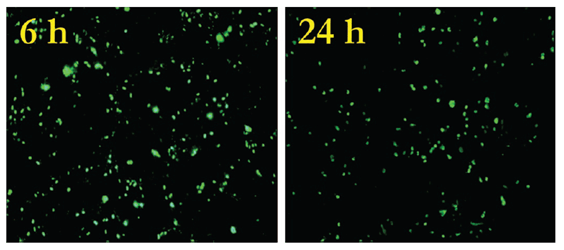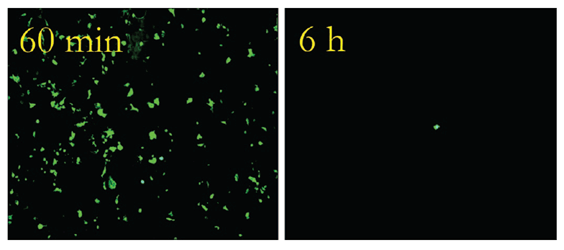Viruses
Influenza A
Influenza A is a virus, familiar to all, which easily travels through the air after respiratory discharges (i.e. sneezing, coughing). Airborne virus particles quickly settle on any surfaces in the vicinity. Active virus particles can then be distributed to additional parts of a facility by touch, potentially putting more people at risk. 2,000,000 virus particles of Influenza A were placed on a stainless steel surface and after six hours, 1,000,000 particles were still active. After 24 hours on the stainless steel, 500,000 particles were still active. When the same amount of Influenza A particles was placed on a copper surface, only 500 remained active after six hours. No active flu particles could be detected on the copper surface after 24 hours. The images compare the reduction of active Influenza A particles on stainless steel and copper. Stainless steel is used for a number of touched surfaces in hospital rooms including: doorknobs, IV poles, railings, and chair arms.
 Active Influenza A Particles on Stainless Steel
Active Influenza A Particles on Stainless Steel
Adenovirus
Adenovirus has been known to cause a variety of upper respiratory and gastrointestinal ailments. Symptoms can be similar to the stomach flu, strep throat and whooping cough, and symptoms can develop into pneumonia, bronchitis and urinary tract infections. Adenovirus is very resilient and can survive for prolonged periods outside of the body. The virus is largely spread by respiratory secretions such as coughing or sneezing. These secretions can precipitate onto surfaces allowing the virus to be spread through contact. 2,000,000 virus particles of Adenovirus were placed on a stainless steel surface and after six hours, 1,000,000 particles were still active. After 24 hours on the stainless steel, 500,000 particles were still active. When the same amount of Adenovirus particles was placed on a copper surface, 500,000 remained active after one hour. Less than 500 active Adenovirus particles could be detected on the copper surface after six hours.
The images compare the reduction of active Adenovirus particles on stainless steel and copper.
 Stainless Steel Samples
Stainless Steel Samples